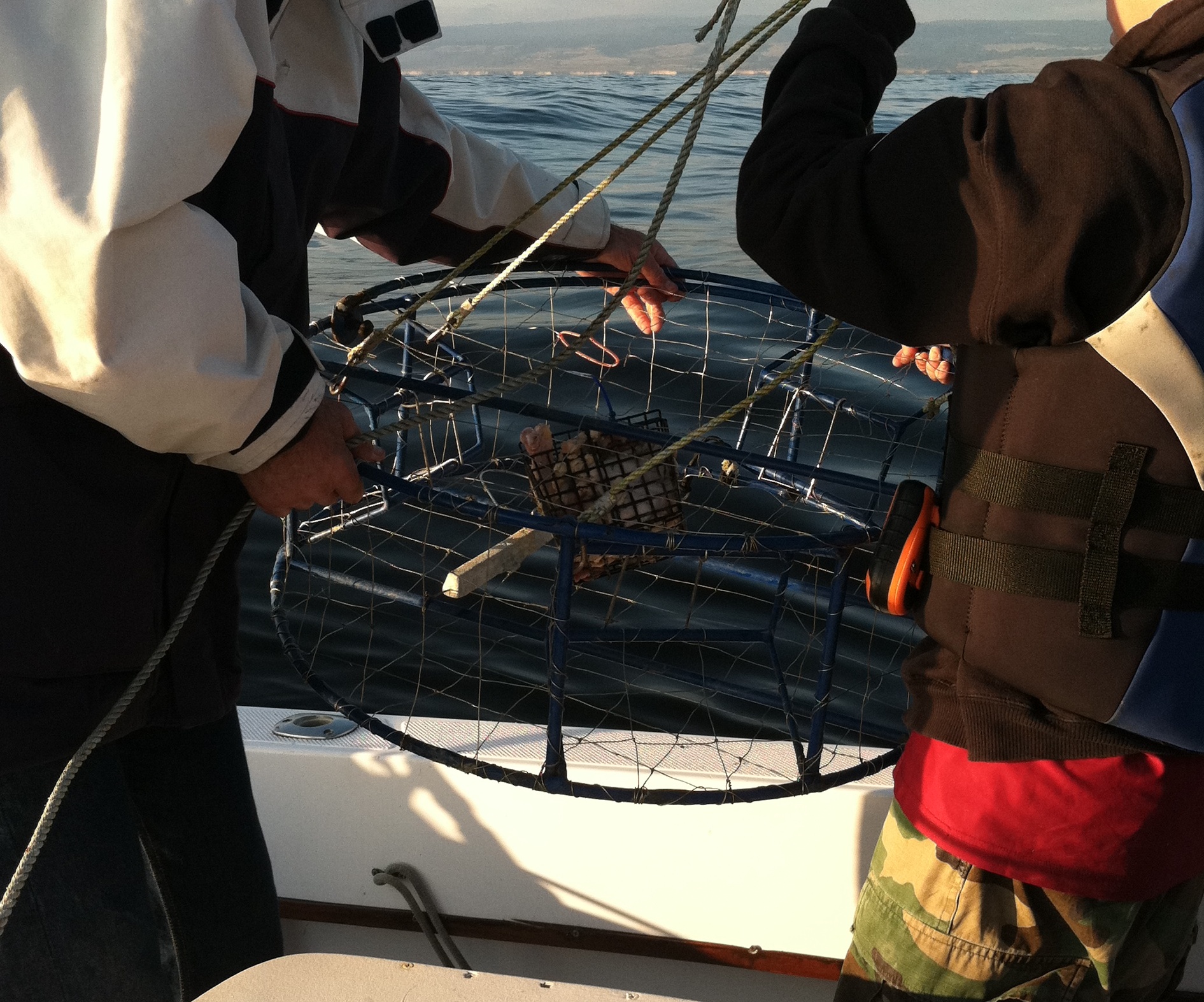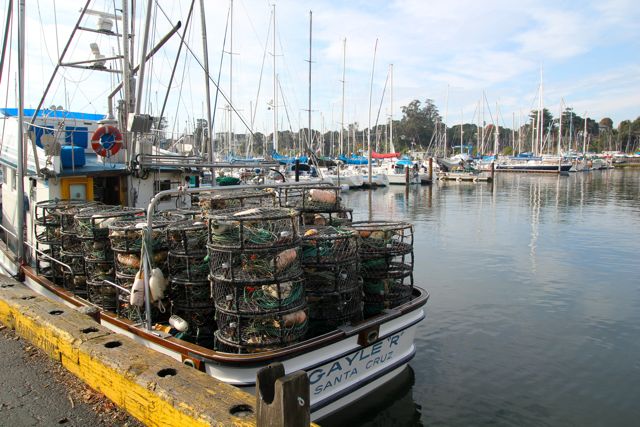One minute I’m milling around the dock of the Santa Cruz harbor, the next minute I’m hurtling out to sea on a 23-foot motorboat named “Aquaholic,” a chilly Pacific gale plastering hair across my face as I shout out questions about crab fishing and scribbling down the answers in a notepad that threatens to be tossed into the drink any second, shortly followed by myself. The driver cuts the engine and all of a sudden we’re bobbing on a glorified cork six miles out to sea. Using all my willpower to keep from tossing my cookies, I watch as a father and his son lower a wiry one-way deathtrap, laden with half a raw chicken, over a hundred feet down to the murky depths below.
Let’s back up: for our news writing class we’ve been assigned to write an advance on the Dungeness crab fishing season. We’ve been told to interview a crab fisherman, so I call up my classmate Helen and we head down to the harbor to find one. The commercial crab season doesn’t start until Tuesday, so the only guys actually fishing are the recreational fisherman, or “Sporties.” We get to the harbor around 3pm on a Saturday. We figure we’ll find a couple of fisherman, they’ll give us some great quotes about the joys of hauling crab, and we’ll call it a day. Easy as seafood pie!
Well, the only guy we can find is a man loading up his motorboat with his two sons. Sheepishly, we ask if he’s a crab fisherman, and he replies, “Yes I am. Wanna come out?” The answer’s out of our mouths before we have time to process whether this is a good idea. “Sure!” The rest is history. All-in-all it was…rather educational.
In case you’re not up-to-snuff on your crab knowledge, here’s a little background on the Dungeness crab:
Its Latin name is Cancer magister (literally, “Master of Cancer”). The name “Dungeness” comes from the port of Dungeness, Washington. The crabs are generally light reddish-brown on the back and white to light orange underneath, with a tinge of purple on the legs. Their pincers (chelipeds) are white-tipped and not just for show. (The fisherman we talked to said he uses tongs to handle the cranky critters.) See the photo below right.
It’s the most abundant crab in California, which is probably why it’s so popular to fish (then again, rats are also pretty abundant and we don’t eat them). The Dungeness lives in eelgrass beds and on the ocean bottom, as far north as Alaska and as far south as Baja California (but aren’t often seen south of Santa Barbara). The males grow to be about 9 inches across, whereas the females rarely get larger than about 6.25 inches.
As a crab grows, its hard shell must be cast off in a process known as “molting.” The shell slits open at the junction of the carapace (front segment) and abdomen (i.e. tail flap) and the crab literally backs out of it, like wriggling out of a sweater. Underneath, a new shell has started growing, but is uncalcified and still soft. The “soft” crab grows rapidly until the new shell hardens. During molting, the crab can actually re-grow missing legs, though it takes a few molts for them to reach normal size again. They molt about once a year.
That’s about all I have to say about these crabs. But there is another kind of crab I want to talk about: the Crab Pulsar!
Recently, a bunch of astrophysicists detected some uber-high energy gamma rays from the Crab pulsar, and the theoretical models have no explanation for it.
A pulsar, by the way, is a highly magnetized rotating neutron star that beams out electromagnetic radiation. A neutron star is formed by the gravitational collapse of a very massive star during a supernova. So basically you have a magnetic ball of neutrons twice the size of the sun spinning around and whipping out pulses of radiation. Pretty insane in itself, if you ask me, but this is old hat to astrophysicists. What isn’t is the high energy of the radiation: gamma-ray pulses with energies greater than 100 billion-electron-volts.
The pulses were detected by the VERITAS (nice acronym, eh?) telescope array at the Whipple Observatory in Arizona. An international group of scientists published a paper about it in the October 7 issue of Science. Nepomuk Otte, a postdoc at UC Santa Cruz, was a corresponding author, and it was his cockamamie idea to look for pulsar emissions in this energy range. Otte’s response?
“To me it’s a real triumph of the experimental approach, not going along with the flow and making assumptions, but just observing to see what there is. And lo and behold, we see something different than what everybody expected.” (as quoted in a UC Santa Cruz press release)
The Crab pulsar was formed by a magnificent supernova in the year 1054, which left behind the Crab Nebula with the pulsar in its center.
It’s one of the most-studied objects in the sky, spinning about 30 times per second and casting a beam of radiation from its magnetic field. The beam moves around like the beacon of a lighthouse, and Earth detects is as rapid pulses of radiation.
Scientists agree on the broad cause of pulsar emissions: electromagnetic forces created by the collapsed star’s rotating magnetic field accelerate charges particles to close to the speed of light, which emit a wide spectrum of radiation. But the devil’s in the details, which are still pretty mysterious.
After studying the Crab for years, scientists predicted that emissions above 10 Giga eV would die off exponentially. So they were flabbergasted when they found emissions above 100 Giga eV. (The prefix Giga = 10^9, or 1 billion)
~Warning! The next paragraph will make you 20 IQ points smarter. Read on at your own risk~
The conventional wisdom of how the emission works is curvature radiation: a dense electron-positron plasma is created near the polar cap of the pulsar, and the charged particles move relativistically with Lorentz factors 102103 along dipolar magnetic field lines, emitting radiation at frequencies that depend on the radius of curvature of the field lines. Phew!
But the results from VERITAS showed something else was going on. It turns out curvature radiation can only explain lower-energy emissions, not the high-energy stuff they observed.
“We really don’t know what causes the very high-energy emission,” said Otte.
(It takes a good scientist to admit they can’t explain something. But it takes a great scientist to come up with a new explanation.)
The scientists think one explanation could be (are you ready for it?): inverse Compton scattering. I won’t go into depth (or I’d be in over my head, to belabor the metaphor), but it involves energy transfer from charged particles to photons. Otte said they still don’t know the details though. They also don’t know if one mechanism explains the radiation at all energy levels, or whether different mechanisms operate at different higher and lower energies.
The next step is to characterize the gamma-ray emission in much greater detail.
So now you know all about crabs and astrophysics. What more is there to life?



